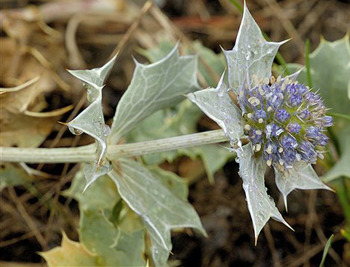Contents:
Common Names | Parts Usually Used | Plant(s) & Culture | Where Found | Medicinal Properties
Legends, Myths and Stories | Uses | Nutrient Content | Bibliography
Scientific Names

- Eryngium maritimum L.
- Umbelliferae
- Umbel family
Common Names
- Eringo
Parts Usually Used
Roots, leaves
Back to Top
Description of Plant(s) and Culture
A beautiful, very hardy perennial; the root grows 8-10 feet long set with rings and circles toward the upper part, cut smooth and without joints down lower, brownish on the outside, and very white within, with a pith in the middle, and the plant grows 1 foot tall with broad, spiny, grayish-blue leaves and pale blue flowers surrounded by spiny bracts. The tough, spiky leaves are of a pearly-gray color. The flowers are blue and mildly scented. blooming at the end of summer. Seeds follow the blooms a month later. The flowers are frequently dried for winter bouquets.
Another variety: Also called sea holly (E. alismaefolium), called “Momono Kaiyu” by the Paiutes, the Native Americans steeped the whole plant to treat diarrhea. This is a tiny plant 2 inches high and is rare.
Back to Top
Where Found
Found on sea coasts. A native of Europe.
Back to Top
Medicinal Properties
Antispasmodic, emmenagogue, stomachic
Back to Top
Legends, Myths and Stories
The decocted root, known as Eryngo, not to be confused with (E. aquaticum) which is also called Eryngo, was once a favorite sweetmeat. It is still popular in the Middle East.
Back to Top
Uses
Roots and leaves are used for uterine irritations and bladder diseases, glandular deficiencies, used as a nervine and tonic. The decoction of the root in wine is very effective on the spleen and liver, helps jaundice, dropsy, treats the French pox, ague, swollen lymph glands, snakebites are healed rapidly, pains of the loins, colic, promotes urine, expels stones, and promotes women’s menses. The roots are nutritious and can be candied for a confection. Like most plants with fragrant blue flowers (lavender and violet), sea holly is good for nerves.
Back to Top
Nutrient Content
Rich in minerals, especially iron, magnesium, silica, and iodine
Back to Top
Bibliography
![]() Culpeper’s Complete Herbal & English Physician: Updated With 117 Modern Herbs
Culpeper’s Complete Herbal & English Physician: Updated With 117 Modern Herbs, by Nicholas Culpeper, Meyerbooks, publisher, PO Box 427, Glenwood, Illinois 60425, 1990, (reprint of 1814)
 The Magic of Herbs
The Magic of Herbs, by David Conway, published by Jonathan Cape, Thirty Bedford Square, London, England. (Out of print)
![]() Indian Uses of Native Plants
Indian Uses of Native Plants, by Edith Van Allen Murphey, Meyerbooks, publisher, PO Box 427, Glenwood, Illinois 60425, copyright 1958, print 1990
![]() Webster’s New World Dictionary
Webster’s New World Dictionary, Third College Edition, Victoria Neufeldt, Editor in Chief, New World Dictionaries: A Division of Simon & Schuster, Inc., 15 Columbus Circle, New York, NY 10023
 The Rodale Herb Book: How to Use, Grow, and Buy Nature’s Miracle Plants (An Organic gardening and farming book)
The Rodale Herb Book: How to Use, Grow, and Buy Nature’s Miracle Plants (An Organic gardening and farming book), edited by William H. Hylton, Rodale Press, Inc. Emmaus, PA, 18049., 1974
